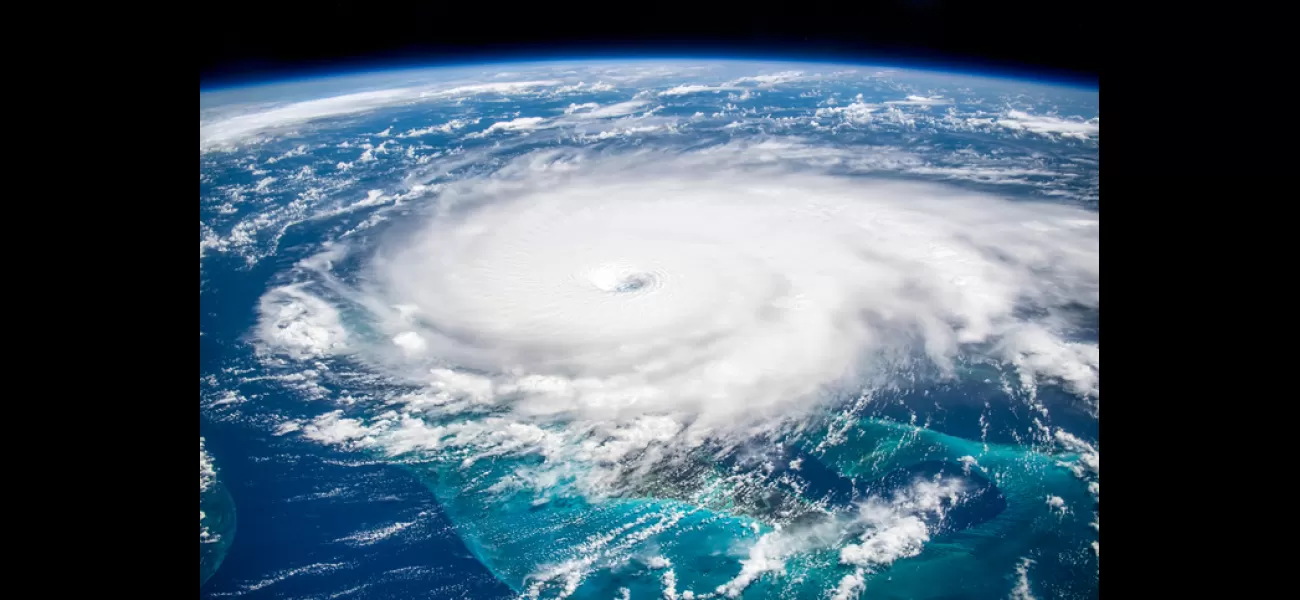Young people are inventing dangerous hurricanes that result in the deaths of many for entertainment.
Welcome to the world of Hypothetical Hurricanes.
February 24th 2024.

It was a calm morning in Honduras, the sun was just starting to rise as the citizens went about their daily routines. However, something was brewing in the distance. Tropical Storm Jose, with its swirling winds and dark clouds, was inching closer and closer to the Honduran coast. The authorities were on high alert, and six hours later, their worst fears were confirmed - Jose had officially become a hurricane. With its winds reaching up to 110mph, the Caribbean Sea was whipped into a frenzy.
As the day progressed, Jose continued to gain strength and was upgraded to a Category 2 storm. By evening, it had reached Central America and caused widespread destruction. The winds were now reaching up to 135mph, making it a Category 4 hurricane. For 24 hours, the catastrophic superstorm unleashed its fury on Honduras, leaving behind a path of devastation. It was declared the deadliest hurricane of 2023, with a death toll of almost 4,000.
Or so they thought.
In a surprising turn of events, it was discovered that Hurricane Jose never actually made landfall. In fact, it wasn't even a hurricane. The storm had formed over the Atlantic and remained there, barely reaching a measly 65mph before being engulfed by another storm. So how did it end up being recorded as a deadly disaster? Welcome to the world of Hypothetical Hurricanes.
Hypothetical Hurricanes is an online community, a wiki developed and run by its users. It is inhabited by storm enthusiasts and weather buffs who spend hours crafting and creating detailed and realistic records of hurricanes. The terminology used is professional, and the developments are accurately depicted. However, the death tolls can sometimes be sky-high.
But here's the twist - none of it is real. It's all just fan fiction. The members of this community use their creativity and imagination to come up with fictional hurricanes, and they do it for the sheer joy of it. For 17-year-old Alex, it's a way to express her creativity and write about something she's passionate about. "It's like poetry, music, or any other form of writing," she explains.
Alex, a former leader of the site, understands the appeal of this community. She also shares that many members, including herself, are on the autistic spectrum and tend to get hooked on subjects they are interested in. Fellow member Lars, also 17, sees it as a unique form of creative expression. He compares it to drawing a picture or writing a fictional book, with no specific end goal in mind.
However, there is a reason why they do what they do. The members of HHW fall into three categories - those who create realistic storms, those who create semi-realistic ones, and those who create completely unrealistic ones. While the latter may be easy to spot with their fictional names like Bikini Bottom or Minecraft hurricane season, others like Storm Jose are not as obvious.
In the past, this has caused some confusion when the hypothetical storms eventually catch up to the present time. Some people have mistaken them for real hurricanes, leading to some amusing incidents. For instance, a reporter from Washington State thought a storm with his name had actually happened and called the community "fake news." Another time, a meteorologist accused the site of spreading false information because one of their articles showed up in search results before the actual Wikipedia article for a storm was written.
However, in the UK, people seem to be less easily fooled. The Met Office is aware of HHW, but they have not received any reports of confusion between real and hypothetical hurricanes. Jim Dale, a consultant meteorologist, sees the potential danger in this. He believes that HHW could be used by climate change deniers to spread false information and undermine the scientific community's efforts.
Since the "fake news" incident, HHW has made it clear on each page that the storms they create are fictional. Despite the occasional confusion, the community remains devoted to their hobby and continues to create elaborate and realistic hypothetical hurricanes. It may seem like a strange fascination to some, but for these storm enthusiasts, it's a way to express their creativity and study the science behind hurricanes. And in a world where natural disasters are becoming more frequent and more intense, their passion for meteorology and climatology may prove to be more relevant than ever.
As the sun rose over Honduras, it seemed like any other day. But little did the locals know, a dangerous storm was lurking just off the coast. Tropical Storm Jose had quickly gained strength and was officially declared a hurricane at 6am. This news was alarming, but it was just the beginning.
Only six hours later, the winds reached a terrifying 110mph, whipping up the Caribbean Sea into a frenzy. The storm was upgraded to a Category 2, and people braced themselves for what was to come. As the evening approached, Hurricane Jose made its way to Central America, bringing with it destructive winds that reached a peak of 135mph. It was now a Category 4 hurricane, and the consequences were devastating.
For 24 long hours, the catastrophic superstorm unleashed its fury on Honduras, leaving destruction in its wake. It was the deadliest hurricane of the year, with a death toll of almost 4,000. But here's the catch – it never actually happened.
That's right, Hurricane Jose was not real. In fact, it wasn't even a hurricane. It was just a tropical storm that formed over the Atlantic and eventually dissipated without making landfall. So how did it end up being recorded as a deadly disaster? Welcome to the world of Hypothetical Hurricanes.
Hypothetical Hurricanes is an online community where storm enthusiasts and weather buffs come together to create detailed and realistic records of imaginary hurricanes. It's like a wiki, where users can develop and run their own sites. The members are dedicated and passionate about their craft, spending hours crafting and perfecting their fictional storms. The level of detail and professionalism is impressive, with accurate terminology and constantly evolving developments.
But why do people devote so much time and energy to creating these hypothetical storms? For many, it's simply a creative outlet. Like writing poetry or making music, it allows them to let their imagination run free and explore a topic they are interested in. As one member, 17-year-old Alex, puts it, "It's just for fun, in the same way that writing or other forms of creative expression are."
But there's also a deeper reason for some members. Many of them are on the autistic spectrum, and they find solace and joy in studying and writing about these fictional hurricanes. For them, it's not about destruction, but rather a way to channel their focus and passion into something productive.
However, not all the storms created on this site are realistic. Some are clearly labeled as fictional, with whimsical names like Bikini Bottom or Minecraft hurricane season. But others, like Hurricane Jose, are not so obvious. And as time goes by, these hypothetical storms can sometimes cause confusion, especially when they are given real names.
In the past, there have been instances where people mistook a fictional storm for a real one. A reporter from Washington State even accused the site of spreading fake news when he saw a storm with his name on it. And a meteorologist claimed that the site was spreading false information because one of the articles showed up in search results before a real Wikipedia page. But in the end, these incidents only serve to highlight the dedication and attention to detail of the members of HHW.
Some may worry that this site could be used for political purposes, with climate change deniers using it to spread misinformation. But for the majority of members, it's simply a place to have fun and explore their interest in meteorology, climatology, and oceanography. And for those who are genuinely interested in the science behind these storms, it can be a valuable learning tool.
Since the "fake news" incident, the HHW page now bears a banner on every article, making it clear that these storms are fictional. And while the site may cause confusion at times, it also serves as a reminder of the power of imagination and the importance of understanding and studying the natural world around us. So next time you see a hurricane with your name on it, just remember – it's all in good fun.
As the day progressed, Jose continued to gain strength and was upgraded to a Category 2 storm. By evening, it had reached Central America and caused widespread destruction. The winds were now reaching up to 135mph, making it a Category 4 hurricane. For 24 hours, the catastrophic superstorm unleashed its fury on Honduras, leaving behind a path of devastation. It was declared the deadliest hurricane of 2023, with a death toll of almost 4,000.
Or so they thought.
In a surprising turn of events, it was discovered that Hurricane Jose never actually made landfall. In fact, it wasn't even a hurricane. The storm had formed over the Atlantic and remained there, barely reaching a measly 65mph before being engulfed by another storm. So how did it end up being recorded as a deadly disaster? Welcome to the world of Hypothetical Hurricanes.
Hypothetical Hurricanes is an online community, a wiki developed and run by its users. It is inhabited by storm enthusiasts and weather buffs who spend hours crafting and creating detailed and realistic records of hurricanes. The terminology used is professional, and the developments are accurately depicted. However, the death tolls can sometimes be sky-high.
But here's the twist - none of it is real. It's all just fan fiction. The members of this community use their creativity and imagination to come up with fictional hurricanes, and they do it for the sheer joy of it. For 17-year-old Alex, it's a way to express her creativity and write about something she's passionate about. "It's like poetry, music, or any other form of writing," she explains.
Alex, a former leader of the site, understands the appeal of this community. She also shares that many members, including herself, are on the autistic spectrum and tend to get hooked on subjects they are interested in. Fellow member Lars, also 17, sees it as a unique form of creative expression. He compares it to drawing a picture or writing a fictional book, with no specific end goal in mind.
However, there is a reason why they do what they do. The members of HHW fall into three categories - those who create realistic storms, those who create semi-realistic ones, and those who create completely unrealistic ones. While the latter may be easy to spot with their fictional names like Bikini Bottom or Minecraft hurricane season, others like Storm Jose are not as obvious.
In the past, this has caused some confusion when the hypothetical storms eventually catch up to the present time. Some people have mistaken them for real hurricanes, leading to some amusing incidents. For instance, a reporter from Washington State thought a storm with his name had actually happened and called the community "fake news." Another time, a meteorologist accused the site of spreading false information because one of their articles showed up in search results before the actual Wikipedia article for a storm was written.
However, in the UK, people seem to be less easily fooled. The Met Office is aware of HHW, but they have not received any reports of confusion between real and hypothetical hurricanes. Jim Dale, a consultant meteorologist, sees the potential danger in this. He believes that HHW could be used by climate change deniers to spread false information and undermine the scientific community's efforts.
Since the "fake news" incident, HHW has made it clear on each page that the storms they create are fictional. Despite the occasional confusion, the community remains devoted to their hobby and continues to create elaborate and realistic hypothetical hurricanes. It may seem like a strange fascination to some, but for these storm enthusiasts, it's a way to express their creativity and study the science behind hurricanes. And in a world where natural disasters are becoming more frequent and more intense, their passion for meteorology and climatology may prove to be more relevant than ever.
As the sun rose over Honduras, it seemed like any other day. But little did the locals know, a dangerous storm was lurking just off the coast. Tropical Storm Jose had quickly gained strength and was officially declared a hurricane at 6am. This news was alarming, but it was just the beginning.
Only six hours later, the winds reached a terrifying 110mph, whipping up the Caribbean Sea into a frenzy. The storm was upgraded to a Category 2, and people braced themselves for what was to come. As the evening approached, Hurricane Jose made its way to Central America, bringing with it destructive winds that reached a peak of 135mph. It was now a Category 4 hurricane, and the consequences were devastating.
For 24 long hours, the catastrophic superstorm unleashed its fury on Honduras, leaving destruction in its wake. It was the deadliest hurricane of the year, with a death toll of almost 4,000. But here's the catch – it never actually happened.
That's right, Hurricane Jose was not real. In fact, it wasn't even a hurricane. It was just a tropical storm that formed over the Atlantic and eventually dissipated without making landfall. So how did it end up being recorded as a deadly disaster? Welcome to the world of Hypothetical Hurricanes.
Hypothetical Hurricanes is an online community where storm enthusiasts and weather buffs come together to create detailed and realistic records of imaginary hurricanes. It's like a wiki, where users can develop and run their own sites. The members are dedicated and passionate about their craft, spending hours crafting and perfecting their fictional storms. The level of detail and professionalism is impressive, with accurate terminology and constantly evolving developments.
But why do people devote so much time and energy to creating these hypothetical storms? For many, it's simply a creative outlet. Like writing poetry or making music, it allows them to let their imagination run free and explore a topic they are interested in. As one member, 17-year-old Alex, puts it, "It's just for fun, in the same way that writing or other forms of creative expression are."
But there's also a deeper reason for some members. Many of them are on the autistic spectrum, and they find solace and joy in studying and writing about these fictional hurricanes. For them, it's not about destruction, but rather a way to channel their focus and passion into something productive.
However, not all the storms created on this site are realistic. Some are clearly labeled as fictional, with whimsical names like Bikini Bottom or Minecraft hurricane season. But others, like Hurricane Jose, are not so obvious. And as time goes by, these hypothetical storms can sometimes cause confusion, especially when they are given real names.
In the past, there have been instances where people mistook a fictional storm for a real one. A reporter from Washington State even accused the site of spreading fake news when he saw a storm with his name on it. And a meteorologist claimed that the site was spreading false information because one of the articles showed up in search results before a real Wikipedia page. But in the end, these incidents only serve to highlight the dedication and attention to detail of the members of HHW.
Some may worry that this site could be used for political purposes, with climate change deniers using it to spread misinformation. But for the majority of members, it's simply a place to have fun and explore their interest in meteorology, climatology, and oceanography. And for those who are genuinely interested in the science behind these storms, it can be a valuable learning tool.
Since the "fake news" incident, the HHW page now bears a banner on every article, making it clear that these storms are fictional. And while the site may cause confusion at times, it also serves as a reminder of the power of imagination and the importance of understanding and studying the natural world around us. So next time you see a hurricane with your name on it, just remember – it's all in good fun.
[This article has been trending online recently and has been generated with AI. Your feed is customized.]
[Generative AI is experimental.]
0
0
Submit Comment





